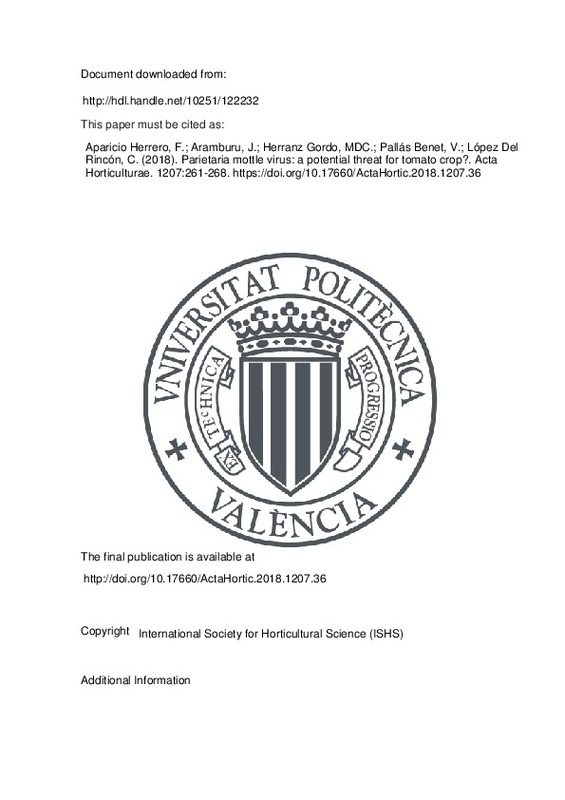JavaScript is disabled for your browser. Some features of this site may not work without it.
Buscar en RiuNet
Listar
Mi cuenta
Estadísticas
Ayuda RiuNet
Admin. UPV
Parietaria mottle virus: a potential threat for tomato crop?
Mostrar el registro sencillo del ítem
Ficheros en el ítem
| dc.contributor.author | Aparicio Herrero, Frederic
|
es_ES |
| dc.contributor.author | Aramburu, J.
|
es_ES |
| dc.contributor.author | Herranz Gordo, Maria Del Carmen
|
es_ES |
| dc.contributor.author | Pallás Benet, Vicente
|
es_ES |
| dc.contributor.author | López Del Rincón, Carmelo
|
es_ES |
| dc.date.accessioned | 2019-06-14T20:42:10Z | |
| dc.date.available | 2019-06-14T20:42:10Z | |
| dc.date.issued | 2018 | es_ES |
| dc.identifier.issn | 0567-7572 | es_ES |
| dc.identifier.uri | http://hdl.handle.net/10251/122232 | |
| dc.description.abstract | [EN] Several isolates of Parietaria mottle virus (PMoV), a member of the genus Ilarvirus, have been described that affect tomato plants. These isolates, named PMoV-T, cause rings and a bright necrotic mosaic on young leaves that progresses to necrosis of the leaves, stem and apex. Fruits of affected plants display corky rings and brown patches, which develop into ridges with necrotic scars. The virus has been described in tomato plants in several European countries, including Italy, France, Greece and Spain. In addition, an outbreak of a necrosis disease of tomato in California in 2008 was shown to be caused by a new ilarvirus species related to PMoV. The genome of PMoV-T is composed of three single-stranded positive-sense RNAs. Phylogenetic analysis of PMoV isolates from different hosts and geographical origins revealed important structural differences and the existence of two coat-protein types according to their size. Moreover, the PMoV isolates sequenced so far clustered in four different clades that were not related with host specificity. Non-isotopic molecular hybridization, tissue printing hybridization, indirect enzyme-linked immunosorbent assay (I-ELISA) and direct tissue-printing immunoassay using a polyclonal antiserum and one-step RT-PCR assays have been set up for routine detection of the virus. The virus was mechanically transmitted from Parietaria officinalis pollen extracts to other host species, including tomato and pepper. In addition, viral transmission can be facilitated by different insect species, some of them used for biological control (e.g., mirids), in a non-persistent manner. It has been suggested that elimination of P. officinalis plants surrounding tomato crops could help to restrain virus spread. However, further studies will be needed to prevent PMoV-T becoming a threat to tomato and pepper crops. | es_ES |
| dc.description.sponsorship | This work was supported by grant BIO2014-54862-R from the Spanish Granting Agency DGICYT, the Prometeo Program GV2011/003 from the Generalitat Valenciana and RTA2008-00010-C03 and RTA2013-00047-C02 from the Instituto Nacional de Investigaciones Agrarias (INIA), cofunded with FEDER 2014-2020 funds. | |
| dc.language | Inglés | es_ES |
| dc.publisher | International Society for Horticultural Science (ISHS) | es_ES |
| dc.relation.ispartof | Acta Horticulturae | es_ES |
| dc.rights | Reserva de todos los derechos | es_ES |
| dc.subject | Ilarvirus | es_ES |
| dc.subject | Mirids | es_ES |
| dc.subject | Parietaria officinalis | es_ES |
| dc.subject | PMoV | es_ES |
| dc.subject | PMoV-T isolates | es_ES |
| dc.subject | Pollen | es_ES |
| dc.subject | Thrips | es_ES |
| dc.subject.classification | GENETICA | es_ES |
| dc.subject.classification | BIOQUIMICA Y BIOLOGIA MOLECULAR | es_ES |
| dc.title | Parietaria mottle virus: a potential threat for tomato crop? | es_ES |
| dc.type | Artículo | es_ES |
| dc.type | Comunicación en congreso | es_ES |
| dc.identifier.doi | 10.17660/ActaHortic.2018.1207.36 | es_ES |
| dc.relation.projectID | info:eu-repo/grantAgreement/MICINN//RTA2008-00010-C03-03/ES/Estudio de los determinantes genéticos de TSWV implicados en la superación de las resistencias de tomate y pimiento. Desarrollo de nuevas variedades resistentes/ | es_ES |
| dc.relation.projectID | info:eu-repo/grantAgreement/MINECO//RTA2013-00047-C02-02/ES/Búsqueda de nuevas fuentes de resistencia y desarrollo de microRNAs artificiales para el control del virus del bronceado del tomate (TSWV)/ | es_ES |
| dc.relation.projectID | info:eu-repo/grantAgreement/MINECO//BIO2014-54862-R/ES/INTERACCIONES ENTRE FACTORES VIRALES Y DEL HUESPED IMPLICADOS EN LOS PROCESOS DE MOVIMIENTO Y PATOGENESIS EN CULTIVOS DE INTERES AGRONOMICO/ | es_ES |
| dc.relation.projectID | info:eu-repo/grantAgreement/GVA//PROMETEO%2F2011%2F003/ | es_ES |
| dc.rights.accessRights | Abierto | es_ES |
| dc.contributor.affiliation | Universitat Politècnica de València. Instituto Universitario Mixto de Biología Molecular y Celular de Plantas - Institut Universitari Mixt de Biologia Molecular i Cel·lular de Plantes | es_ES |
| dc.contributor.affiliation | Universitat Politècnica de València. Departamento de Biotecnología - Departament de Biotecnologia | es_ES |
| dc.description.bibliographicCitation | Aparicio Herrero, F.; Aramburu, J.; Herranz Gordo, MDC.; Pallás Benet, V.; López Del Rincón, C. (2018). Parietaria mottle virus: a potential threat for tomato crop?. Acta Horticulturae. 1207:261-268. https://doi.org/10.17660/ActaHortic.2018.1207.36 | es_ES |
| dc.description.accrualMethod | S | es_ES |
| dc.relation.conferencename | 5th International Symposium on Tomato Diseases | es_ES |
| dc.relation.conferencedate | Junio 13-16,2016 | es_ES |
| dc.relation.conferenceplace | Málaga, España | es_ES |
| dc.relation.publisherversion | http://doi.org/10.17660/ActaHortic.2018.1207.36 | es_ES |
| dc.description.upvformatpinicio | 261 | es_ES |
| dc.description.upvformatpfin | 268 | es_ES |
| dc.type.version | info:eu-repo/semantics/publishedVersion | es_ES |
| dc.description.volume | 1207 | es_ES |
| dc.relation.pasarela | S\377186 | es_ES |
| dc.contributor.funder | Generalitat Valenciana | es_ES |
| dc.contributor.funder | Ministerio de Ciencia e Innovación | es_ES |
| dc.contributor.funder | Ministerio de Economía y Competitividad | es_ES |







![[Cerrado]](/themes/UPV/images/candado.png)

